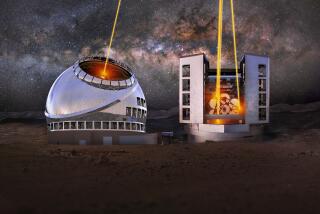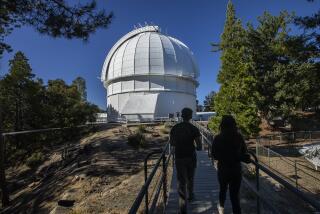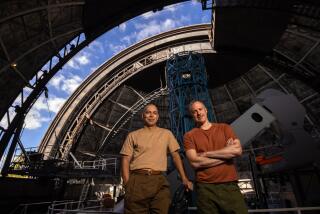A Clearer View
- Share via
Ever since the 1920’s when Edwin Hubble used his clear perch atop Mt. Wilson to discover that the Milky Way was not the only galaxy in the cosmos, the Mt. Wilson Observatory northeast of Los Angeles has remained on top of things in astronomy. Now, it is poised to leap into the millennium with a new system of telescopes that will make the view even better. Called interferometry, because it makes use of the same interference patterns of light waves that produce the colors in oil slicks, the new technique is incorporated into plans for virtually every new telescope, as well as most existing ones. Mt. Wilson’s array will complement the observatory’s 100-inch and 60-inch telescopes with six new scopes (numbered below), arranged in a Y-shaped pattern. Friday morning, weather permitting, helicopters will be used to lower six domes onto their bases. When completed sometime in 2000, the array should provide the sharpest resolution of stars ever achieved. Called CHARA, or Center for High Angular Resolution Astronomy, the project is funded by Georgia State University, the National Science Foundation, the W.M. Keck Foundation and the David and Lucile Packard Foundation.
*
Vacuum tubes
Tubes for each telescope are eight inches wide to accommodate 5-inch-wide light beams as they travel to the central station.
Beam synthesis facility
100” Hooker telescope
60” telescope
First two telescope to be operational
*
Mt. Wilson: 5,800 feet
Inversion Layer: 4,000-5,000 feet
Ocean turbulence: 4-5 feet above surface
Why Mt. Wilson?
The stable air at the site provides some of the best “seeing” in the world. Ironically, this clear view is produced by the same inversion layer that traps smog in the cities below. The layer forms a high-pressure ceiling around the San Gabriel Mountains, keeping a lid on the muck while diverting cool, clear sea air to the mountain tops. While light pollution from below prevents Mt. Wilson instruments from peering deep into the universe, the still, clear air produces the sharpest images of individual stars anywhere.
The Telescopes
Each of the one-meter telescopes will be housed in a seven-ton steel dome. Helicopters will lower the six domes onto their bases Friday morning. The first pair of telescopes is scheduled to be operating by June.
18 feet in diameter
28 to 45 feet high
Prefabricated dome
Telescope
Upper shroud wall
Lower shroud Telescope mount pedestal
Telescope mount table
Top of shroud pier
Foundation pier
How Interferometry Works
Interferometry works somewhat like a magnifying glass that sharpens images by adding up and subtracting lightwaves. Where the crests of two waves meet, the doubled energy produces a bright band; where a crest meets a trough, the light energy is canceled, producing darkness. These patterns of light and dark are much bigger than the individual light waves themselves, allowing detection of very subtle underlying patterns. The same general principle was used in many seminal scientific discoveries, including the astonishing finding that the so-called luminiferous ether, believed by all scientists before Einstein to pervade all space, did not exist. Today, the technique underlies everything from inertial guidance systems used in commercial airplanes to gravity-wave telescopes and crystallography. Eventually, space-based interferometers will be needed to see if any Earth-like planets orbit other stars.
*
Constructive Interference
Destructive Interference
What the Telescopes Will Reveal
For the first time, astronomers will be able to extensively study stars as extended disks rather than simply points of light. This will help them track the birth and evolution of stars and the precise orbits of double stars as they circle each other. The resolution will be sharp enough to see a nickel from 10,000 miles, and possibly good enough to discover new planets.
How Will Interferometry Work at Mt. Wilson?
Light collected from each of the telescopes will be combined in the central beam synthesis facility, with the resulting patterns producing an image. To provide an equivalent image, a telescope of traditional design would have to be 1,800 feet in diameter.
Optical Delay Line Cart
The cart synchronizes the telescope beam paths to about a millionth of an inch. Two carts are seen below on their tracks in the 100-yard-long beam synthesis facility.
Beam Synthesis Facility
The building is specially insulated so that no vibration, heat or cold affects the beams. A large optic table contains a metrology laser capable of tracking the position of eight carts, and it has lenses for focusing the beam from each telescope.
Sources: Georgia State University; Sea West Enterprises
Researched by K.C. COLE and JULIE SHEER / Los Angeles Times
More to Read
Sign up for The Wild
We’ll help you find the best places to hike, bike and run, as well as the perfect silent spots for meditation and yoga.
You may occasionally receive promotional content from the Los Angeles Times.






